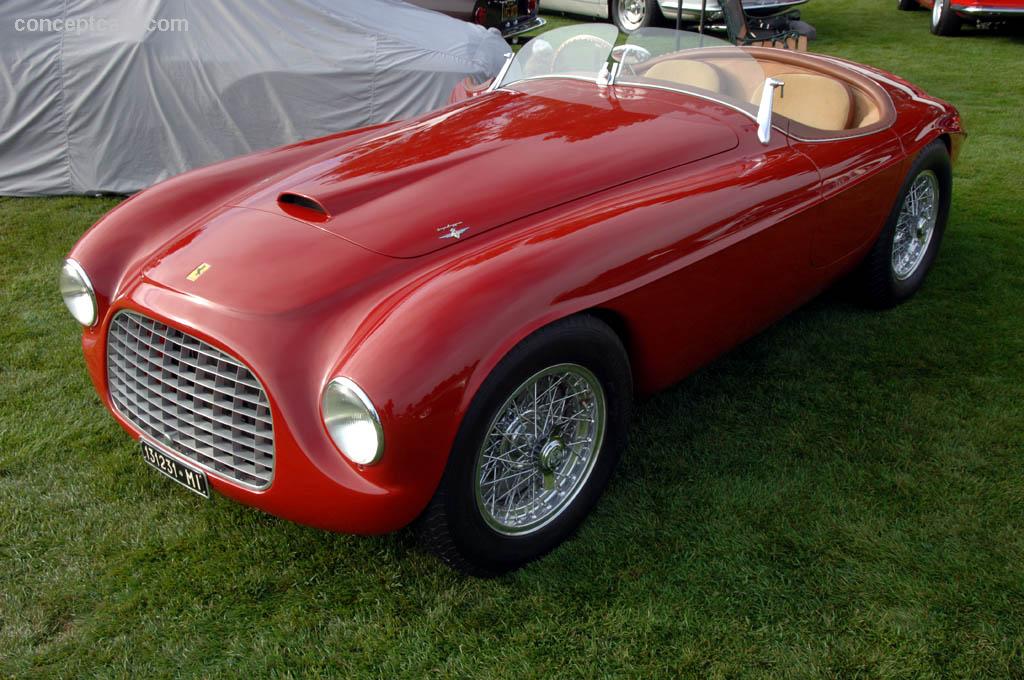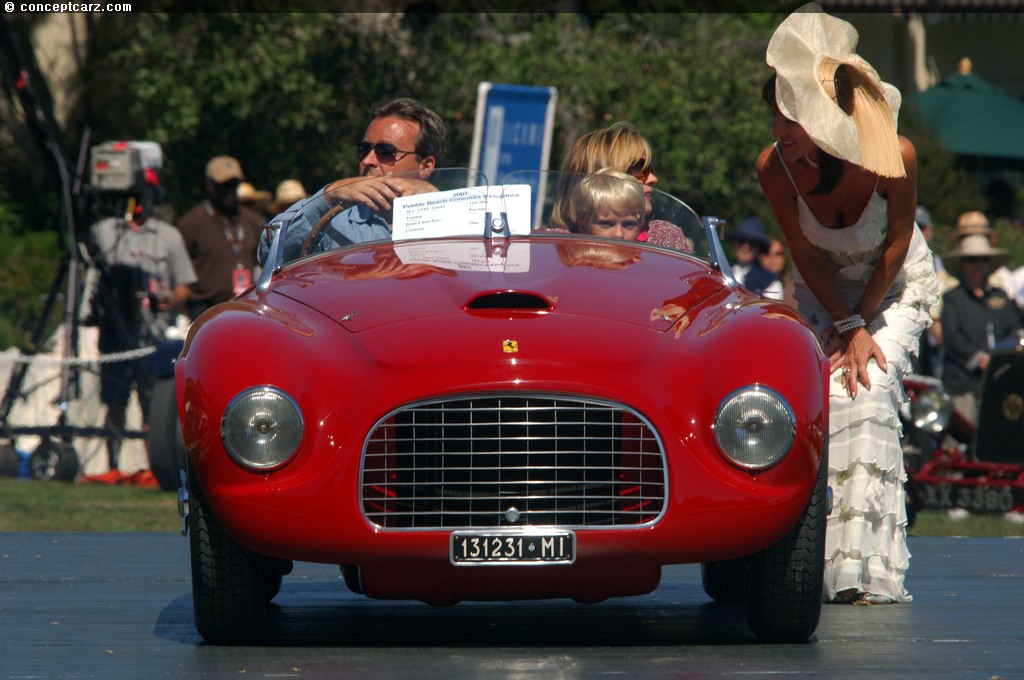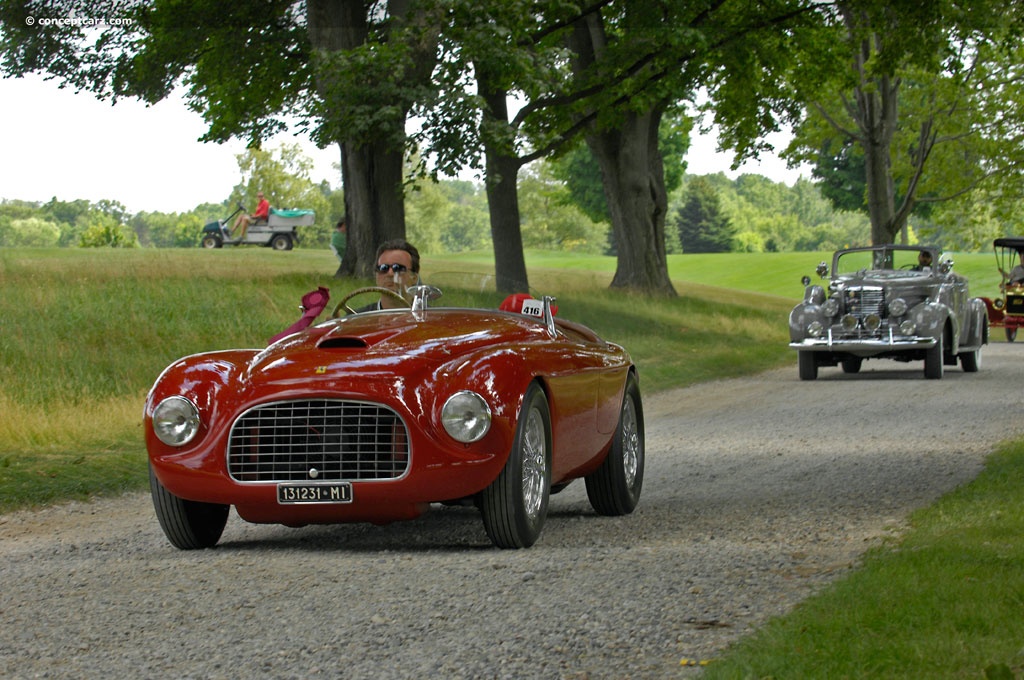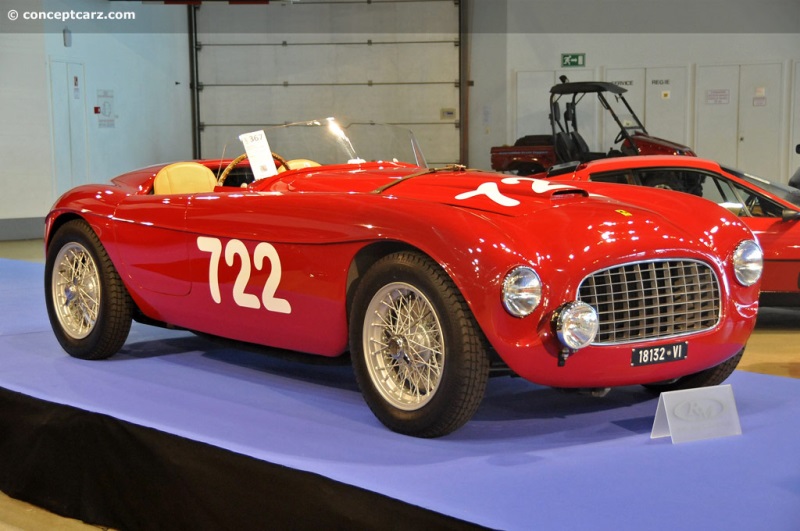Ferrari of Modena, Italy built two examples of the 1.5-liter 125 S race car in 1947, the first car to bear the Ferrari name. The first car to wear a Ferrari badge on the radiator cowl was the Alfa Romeo Bimotore constructed in 1935 by Enzo Ferrari and Luigi Bazzi. At the time, Ferrari managed numerous drivers from his headquarters in Viale Trento e Trieste, Modena, Italy, until 1938, when Alfa Romeo made him the manager of the factory racing division, Alfa Corse. In 1937, Alfa Romeo had acquired the shares of the Scuderia Ferrari and beginning on January 1st of 1938, transferred the official racing activity to Alfa Corse. Enzo was dismissed by Alfa in 1939 following disagreements with policies, so Enzo formed his own company, Auto Avio Costruzioni Ferrari, which also manufactured machine tools. Due to agreements with Alfa, Enzo was unable to use the Ferrari name on cars for four years. 
Barchetta by Touring
Chassis #: 0006M
Engine #: 0004M
View info and historyEnzo Ferrari's Auto Avio Costruzioni 815 had been built in 1940, and was equipped with an inline-8 while the 125 S was equipped with a Gioacchini Colombo-designed 1,497cc V12 engine with a 9.5:1 compression ratio, single overhead camshafts, two valves per cylinder, and three double-choke Weber 30DCF carburetors. It used a steel tube-frame chassis with a double wishbones suspension system with transverse leaf springs in front with a live axle in the rear. Stopping power was provided by hydraulic power drum brakes in the front and rear. The Tipo 166 Sport replaced the 125 S and would ultimately establish Enzo Ferrari's Modenese workshop as a leading manufacturer of racing cars, defining the sound, look, and character of future Ferrari automobiles. The evolution and development of these early Ferrari vehicles were ongoing with many examples often reworked into later models to suit competition opportunities. At the time, Ferrari was a nascent commercial enterprise and due to the recent conclusion of World War II, resources were scarce. Except for labor, everything was scarce including quality materials and machinery essential for the construction of high-performance racing cars. With Formula 2 racing regulations adopting a two-liter limit for competition, Ferrari and Bazzi increased the 125's 55x52.5mm bore and stroke to 59x58mm for the 1902cc 159 engine which appeared late in 1947. Displacement grew to nearly two liters for the 1948 season with the first version (of which few were built), had a 1968cc displacement with a 60mm bore and 58mm stroke. Another slight increase in stroke to 58.8mm brought the engine closer to the 2-liter limit, at 1,995cc. Just like the 125, the 166 Model was named in reference to the unitary displacement (166.25cc per cylinder), a naming convention that would be used by Ferrari for many decades.
Barchetta by Touring
Chassis #: 0006M
Engine #: 0004M
View info and historyThe early 166 Sports and Spider Corsas achieved success in their own right, with the cycle fendered Botticelli-style Spider Corsa bodies adaptable to both Formula 2 and sports car competition. Two 166 Sports models were built on long-wheelbase (2620mm) platforms, with one wearing coupe coachwork by Allemano. It was driven by Clemente Biondetti and Giuseppe Navone to an overall victory in the 1948 Mille Miglia, and capitalizing on the victory, Ferrari called the new 166 'Mille Miglia' - or MM - and it would dominate sports car racing during the late 1940s and early 1950s. Among the accolades were victories at the 24 Hours of Le Mans, the Targa Florio, and the Mille Miglia. Biondetti scored his third consecutive Mille Miglia victory in his 166 early in 1949, Luigi Chinetti and Lord Selsdon won the 1949 24 Hours of LeMans, and Chinetti and Jean Lucas won at the Spa 24 Hours. The coachbuilder most closely associated with the Ferrari marque during this era was Carrozzeria Touring, based in Milan and headed by Carlo Felice Bianchi Anderloni. The designs were elegant, and the technically advanced Superleggera construction complemented the sporting characteristics of the simple yet effective chassis. The frame was comprised of two oval tubes with X-members for torsional strength, and the body was supported by outriggers. This design made it possible for Ferrari to cater the wheelbase size to various types of racing, and to accommodate different passenger configurations. The rear suspension used a simple live axle with semi-elliptical leaf springs and trailing arms to control axle location and torque, also with Houdaille shocks. The front setup was independent with parallel A-arms supported by a transverse leaf spring and snubbed by Houdaille lever-action hydraulic shock absorbers. All four wire wheels hide the large drum brakes.The Ferrari 166 MM was introduced at the Turin Motor Show in November of 1948 and built in two versions. A long wheelbase 'coupé 2-3 posti' (known as a 2+2 in modern nomenclature) rested on the Touring stand and shared design elements with the Touring-bodied 2-seat roadster (spider da corsa) on Ferrari's stand. The spider da corsa had a wheelbase of 2200mm (86.5-inches), yet despite its small stature had an aggressive (yet graceful) appearance. Design cues included a large and oval grille with egg crate trim with horizontal bars. A swage line traversed the bodyside, beginning at behind the front wheel wells and continuing back to, and over, the rear wheel. The design would later influence several future vehicles including vehicles from the AC Bristol.
Barchetta by Touring
Chassis #: 0006M
Engine #: 0004M
View info and historyBy the time production of the first series 166 MM ended in 1951, a total of twenty-six Touring Barchettas ('little boat') had been built. Eleven examples of the 166 MM were built in 1949 followed by a further thirteen examples in 1950. Six examples were retained by Scuderia Ferrari while the remainder were sold and raced by privateers including the Marzotto brothers, Franco Cornacchia and Inico Bernabei. The Colombo engine powering the 166 would later be used (with the same bore but different stroke) in the company's first series production model, the 250 GT.
by Daniel Vaughan | Sep 2021

Barchetta by Touring
Chassis #: 0006M
Engine #: 0004M
View info and history

Barchetta by Touring
Chassis #: 0006M
Engine #: 0004M
View info and history

Barchetta by Touring
Chassis #: 0006M
Engine #: 0004M
View info and history
by Daniel Vaughan | Sep 2021
Related Reading : Ferrari 166 History
Clemente Biondetti and Count Igor Troubetzkoy won the Targa Florio on April 3rd of 1948, marking Ferraris first major international win. The car was a closed Berlinetta Ferrari 166 and would later capture a victory at Italys most important race, the Mille Miglia in 1948. The Ferrari 166 was officially introduced at the Turin Salon in September of 1948. The body was courtesy of Touring utilizing....
Continue Reading >>
Continue Reading >>
Related Reading : Ferrari 166 History
It was in 1948 when the newly formed Italian automobile company named Ferrari began selling a promising sports car named the 166. The two-seater sports car featured a 12-cylinder engine mounted in the front and supplying over 100 horsepower to the rear wheels. The engine was just under two-liters in size and had a unitary displacement of 166 cc, thus, the evolution of the model name. Production would....
Continue Reading >>
Continue Reading >>
Similar Vehicles
Similar Automakers
Similarly Sized Vehicles
from 1948
1948 Ferrari 166 MM Vehicle Profiles
Recent Vehicle Additions
Performance and Specification Comparison
166 Specification Comparison by Year
Year
Production
Wheelbase
Engine
Prices
Related Automotive News

Phenomenal Ferraris and Italian Thoroughbreds Offered at Gooding & Company's Pebble Beach Auctions
The auction house announced a stable of Italian star cars, including a 1950 Ferrari 166 MM Berlinetta Le Mans, a 1961 Ferrari 400 Superamerica Series I Coupe Aerodinamico, and a 1954 Ferrari 500 Mondial Series I Spider.
A stunning group of star...

Ex-Scuderia Ferrari Alfa Romeo 8C 2300 Monza Spider By Zagato Scoops Best Of Show At Salon Privé
Alfa Romeo 8C 2300 Monza Spider by Zagato raced by Tazio Nuvolari wins top award
Leading designers present inaugural Churchill Cup to rare Lancia Astura
Duke of Marlborough selects his favourites on two wheels and four
Record entry for the UKs...

Ferrari Museum Celebrates Scuderia Ferrari's Landmark Anniversary With The '90 Years Exhibition'
Hypercars the story of Ferraris technological evolution told through milestone cars
Maranello, xx May 2019 – One of the great iconic names in motorsport with the power to unite an entire country and millions of fans from all over the...

LANDMARK FERRARI 275S/340 AMERICA BARCHETTA LEADS EARLY HIGHLIGHTS FOR RM SOTHEBY'S FLAGSHIP MONTEREY AUCTION
RM Sothebys secures 1950 Ferrari 275S340 America Barchetta, chassis 0030 MT, for its flagship Monterey sale, August 14-15 in California
A Scuderia Ferrari 12-cylinder Barchetta, 0030 MT was raced by such legends in period as Alberto Ascari, Gio...
Luigi Musso: Talented, Tempting and Troubled
Following Alberto Ascaris back-to-back titles in 1952 and 1953 there have been no Italian Formula One World Champions. While there has been a great amount of hope throughout the years, Italians have been left without a World Champion. Perhaps, it could...



































